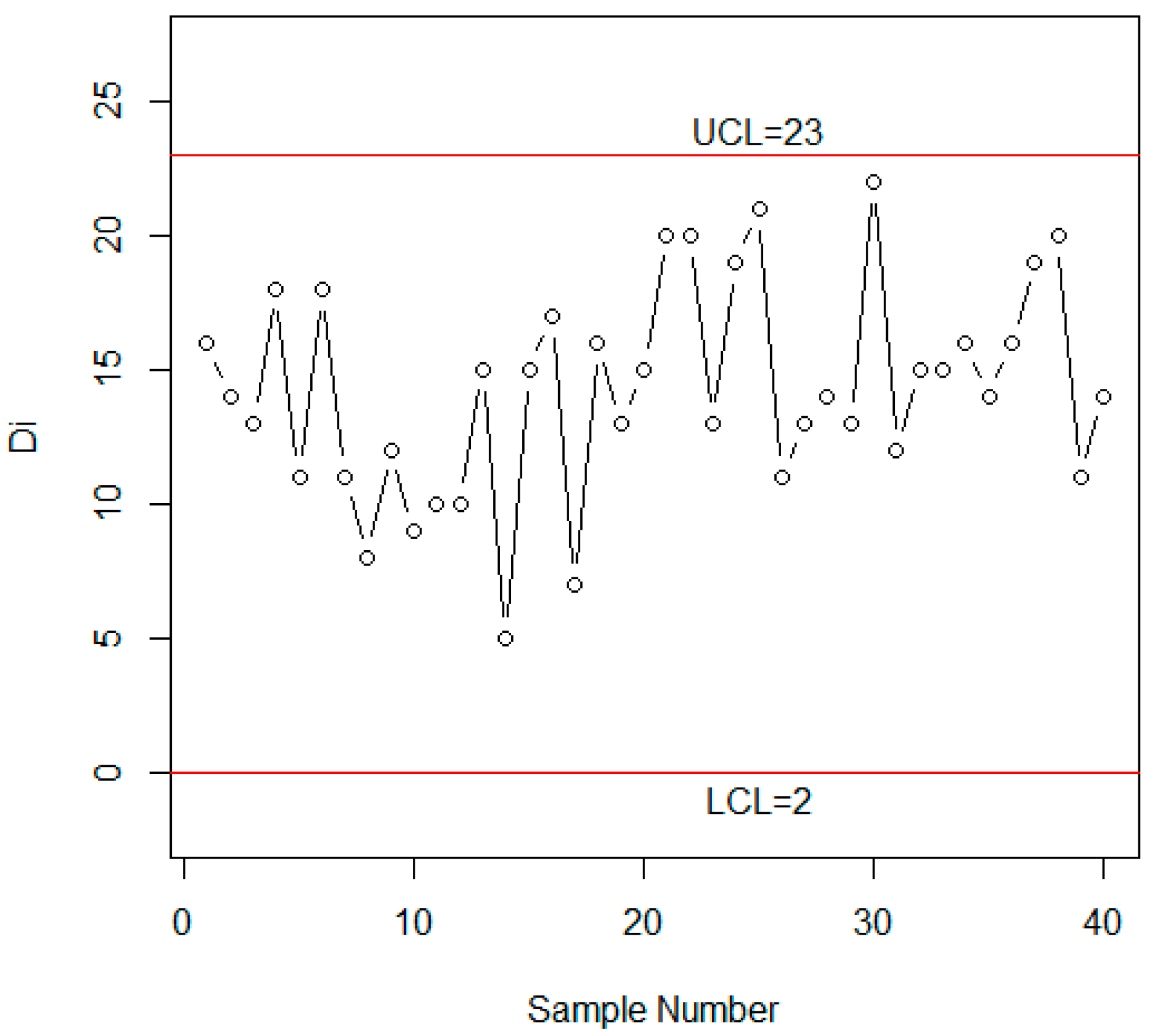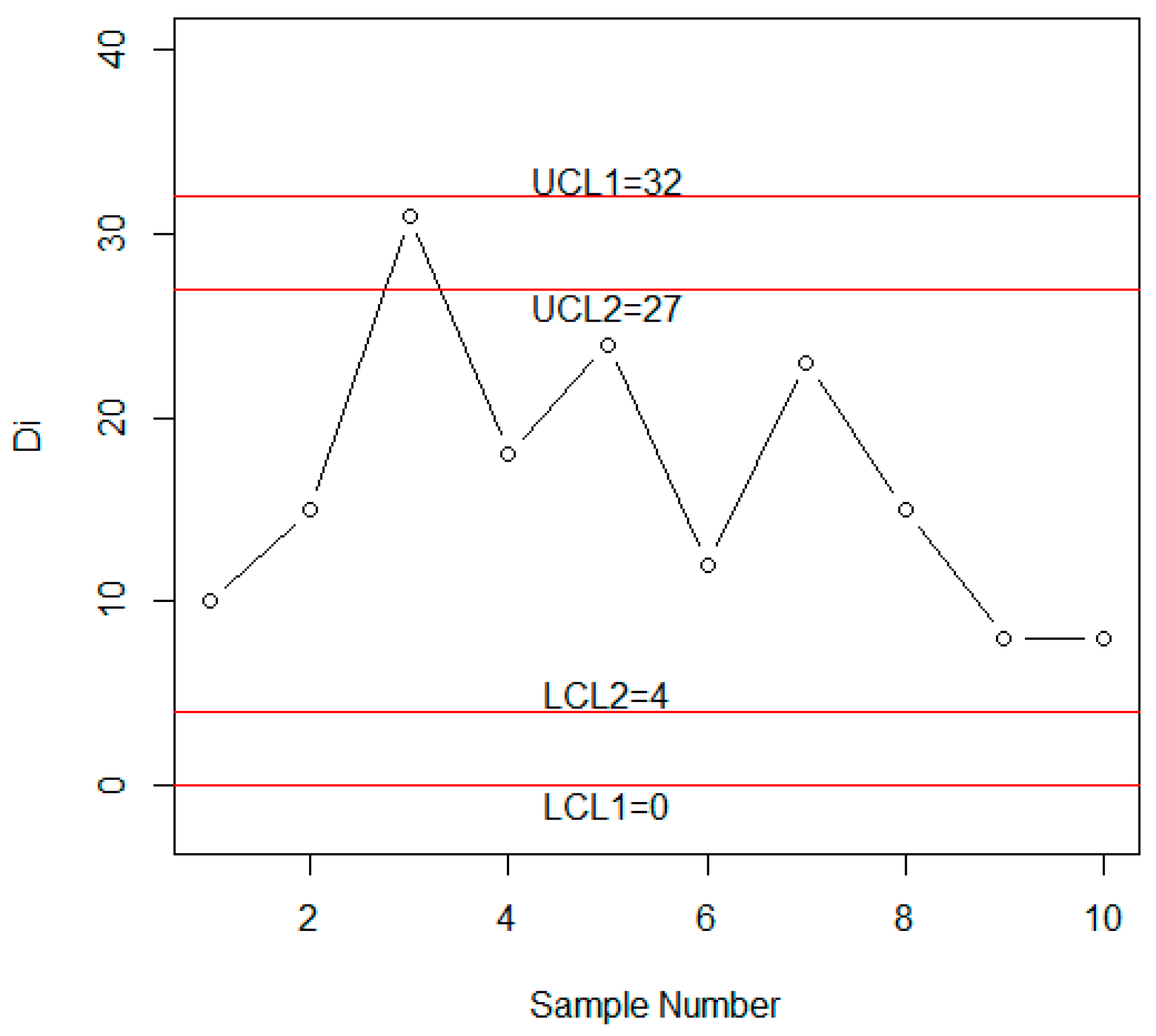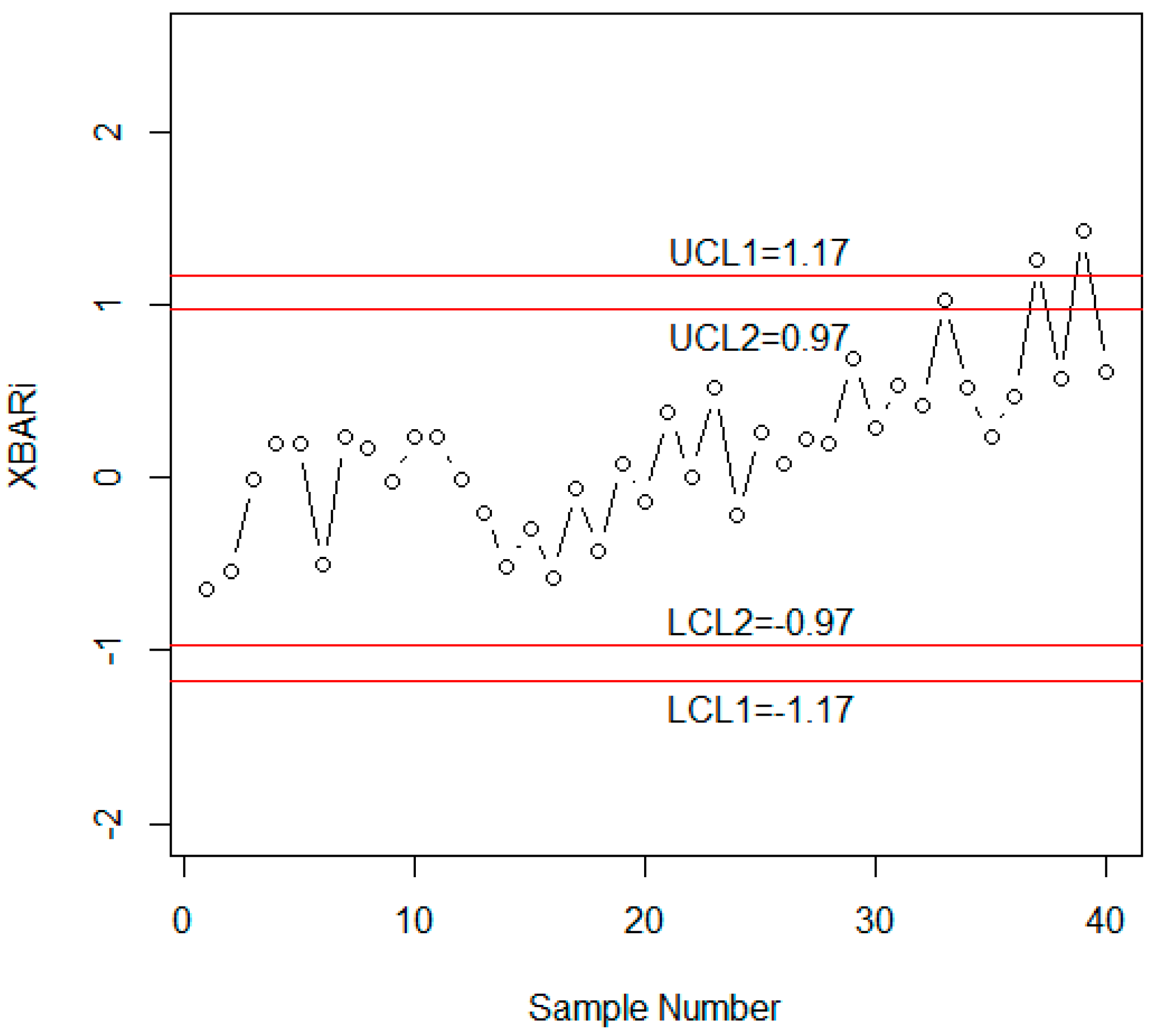Shewhart Attribute and Variable Control Charts Using Modified Multiple Dependent State Sampling
Abstract
:1. Introduction
2. Attribute Chart Using Modified Multiple Dependent State (MDS) Sampling
2.1. In-Control Process
2.2. Shifted (or Out-Of-Control) Process
3. ARLs of the Attribute Chart Using Modified MDS Sampling
4. Comparison of the Proposed Chart with Existing MDS chart
4.1. Simulation Study
4.2. An Industrial Example
5. Variable Chart Using Modified MDS Sampling
5.1. In-Control Process
5.2. Shifted (or Out-Of-Control) Process
6. ARLs of Variable Chart Using Modified MDS Sampling
7. Comparison of the Proposed Chart with Existing MDS Chart
7.1. Simulation Study
7.2. An industrial Example
8. Conclusions
Author Contributions
Funding
Acknowledgments
Conflicts of Interest
References
- Montgomery, D.C. Introduction to Statistical Quality Control, 6th ed.; John Wiley & Sons, Inc.: New York, NY, USA, 2009. [Google Scholar]
- Balamurali, S.; Jeyadurga, P.; Usha, M. Designing of Bayesian multiple deferred state sampling plan based on gamma–Poisson distribution. Am. J. Math. Manag. Sci. 2016, 35, 77–90. [Google Scholar] [CrossRef]
- Wortham, A.W.; Baker, R.C. Multiple deferred state sampling inspection. Int. J. Prod. Res. 1976, 14, 719–731. [Google Scholar] [CrossRef]
- Soundararajan, V.; Vijayaraghavan, R. On designing multiple deferred state sampling (MDS-1 (0, 2)) plans involving minimum risks. J. Appl. Stat. 1989, 16, 87–94. [Google Scholar] [CrossRef]
- Soundararajan, V.; Vijayaraghavan, R. Construction and selection of multiple dependent (deferred) state sampling plan. J. Appl. Stat. 1990, 17, 397–409. [Google Scholar] [CrossRef]
- Govindaraju, K.; Subramani, K. Selection of multiple deferred (dependent) state sampling plans for given acceptable quality level and limiting quality level. J. Appl. Stat. 1993, 20, 423–428. [Google Scholar] [CrossRef]
- Balamurali, S.; Jun, C.-H. Multiple dependent state sampling plans for lot acceptance based on measurement data. Eur. J. Oper. Res. 2007, 180, 1221–1230. [Google Scholar] [CrossRef]
- Aslam, M.; Khan, N.; Jun, C.-H. A Multiple Dependent State Control Chart Based on Double Control Limit. Res. J. Appl. Sci. Eng. Technol. 2014, 7, 4490–4493. [Google Scholar] [CrossRef]
- Aslam, M.; Nazir, A.; Jun, C.-H. A new attribute control chart using multiple dependent state sampling. Trans. Inst. Meas. Control 2015, 37, 569–576. [Google Scholar] [CrossRef]
- Zhou, W.; Wan, Q.; Zheng, Y.; Zhou, Y.-W. A joint-adaptive np control chart with multiple dependent state sampling scheme. Commun. Stat. Theory Methods 2017, 46, 6967–6979. [Google Scholar] [CrossRef]
- Yan, A.; Liu, S.; Dong, X. Designing a multiple dependent state sampling plan based on the coefficient of variation. SpringerPlus 2016, 5, 1447. [Google Scholar] [CrossRef] [PubMed]
- Aslam, M.; Azam, M.; Khan, N.; Jun, C.-H. A control chart for an exponential distribution using multiple dependent state sampling. Qual. Quant. 2015, 49, 455–462. [Google Scholar] [CrossRef]
- Aslam, M.; Azam, M.; Jun, C.-H. Multiple dependent state sampling plan based on process capability index. J. Test. Eval. 2013, 41, 1–7. [Google Scholar] [CrossRef]
- Kuralmani, V.; Govlndaraju, K. Selection of multiple deferred (dependent) state sampling plans. Commun. Stat. Theory Methods 1992, 21, 1339–1366. [Google Scholar] [CrossRef]
- Vaerst, R. A procedure to construct multiple deferred state sampling plan. Methods Oper. Res. 1982, 37, 477–485. [Google Scholar]
- Govindaraju, K.; Lai, C. A modified ChSP-1 chain sampling plan, MChSP-1, with very small sample sizes. Am. J. Math. Manag. Sci. 1998, 18, 343–358. [Google Scholar] [CrossRef]
- Chananet, C.; Sukparungsee, S.; Areepong, Y. The ARL of EWMA chart for monitoring ZINB model using Markov chain approach. Int. J. Appl. Phys. Math. 2014, 4, 236. [Google Scholar] [CrossRef]










| = 2 | = 3 | |||||
|---|---|---|---|---|---|---|
| 201.7800 | 301.5360 | 370.6202 | 200.9965 | 305.2319 | 373.4875 | |
| 4.8498 | 3.4960 | 3.6292 | 5.1498 | 3.7202 | 3.9085 | |
| 2.9614 | 3.4723 | 3.5639 | 3.6066 | 3.4506 | 3.4507 | |
| n | 810 | 900 | 880 | 680 | 920 | 900 |
| Shift | ||||||
| 1.00 | 201.78 | 301.54 | 370.62 | 201.00 | 305.23 | 373.49 |
| 1.01 | 188.49 | 273.78 | 339.37 | 209.70 | 276.88 | 342.11 |
| 1.03 | 163.20 | 224.71 | 281.99 | 225.50 | 226.49 | 283.89 |
| 1.05 | 140.34 | 183.98 | 232.62 | 237.95 | 184.58 | 233.43 |
| 1.07 | 120.23 | 150.71 | 191.33 | 245.73 | 150.38 | 191.13 |
| 1.10 | 95.16 | 112.31 | 142.83 | 246.62 | 111.07 | 141.53 |
| 1.13 | 75.49 | 84.47 | 107.28 | 234.44 | 82.76 | 105.36 |
| 1.15 | 64.88 | 70.29 | 89.09 | 220.41 | 68.43 | 86.97 |
| 1.17 | 55.92 | 58.79 | 74.32 | 203.29 | 56.88 | 72.11 |
| 1.20 | 45.01 | 45.42 | 57.16 | 174.96 | 43.54 | 54.96 |
| 1.25 | 31.90 | 30.32 | 37.84 | 129.61 | 28.64 | 35.85 |
| 1.30 | 23.11 | 20.89 | 25.83 | 93.29 | 19.46 | 24.14 |
| 1.40 | 12.90 | 10.83 | 13.14 | 48.19 | 9.84 | 11.97 |
| 1.50 | 7.76 | 6.25 | 7.43 | 26.04 | 5.57 | 6.63 |
| 1.70 | 3.45 | 2.74 | 3.12 | 9.04 | 2.40 | 2.73 |
| 1.80 | 2.52 | 2.05 | 2.28 | 5.81 | 1.80 | 2.00 |
| 2.00 | 1.60 | 1.38 | 1.48 | 2.85 | 1.25 | 1.33 |
| = 2 | = 3 | |||||
|---|---|---|---|---|---|---|
| 200.4457 | 301.5679 | 371.4451 | 200.1407 | 300.1609 | 370.1112 | |
| 3.5377 | 4.5655 | 4.3772 | 6.1016 | 3.5814 | 5.6740 | |
| 2.9214 | 2.9908 | 3.1114 | 2.9065 | 3.0666 | 3.1167 | |
| n | 290 | 275 | 270 | 225 | 395 | 315 |
| Shift | ||||||
| 1.00 | 200.45 | 301.57 | 371.45 | 200.14 | 300.16 | 370.11 |
| 1.01 | 177.09 | 266.99 | 328.98 | 180.06 | 259.69 | 324.69 |
| 1.03 | 138.23 | 209.93 | 258.33 | 146.05 | 193.00 | 250.51 |
| 1.05 | 108.23 | 165.99 | 203.62 | 118.95 | 143.30 | 194.32 |
| 1.07 | 85.20 | 132.11 | 161.37 | 97.33 | 106.92 | 151.76 |
| 1.10 | 60.28 | 95.04 | 115.23 | 72.75 | 69.98 | 106.19 |
| 1.13 | 43.37 | 69.47 | 83.54 | 55.03 | 46.82 | 75.56 |
| 1.15 | 35.17 | 56.86 | 67.99 | 45.98 | 36.27 | 60.76 |
| 1.17 | 28.73 | 46.85 | 55.71 | 38.61 | 28.39 | 49.20 |
| 1.20 | 21.52 | 35.47 | 41.82 | 29.98 | 20.04 | 36.29 |
| 1.25 | 13.79 | 22.99 | 26.73 | 20.12 | 11.78 | 22.51 |
| 1.30 | 9.23 | 15.43 | 17.71 | 13.87 | 7.35 | 14.47 |
| 1.40 | 4.68 | 7.65 | 8.57 | 7.12 | 3.40 | 6.60 |
| 1.50 | 2.76 | 4.27 | 4.69 | 4.05 | 1.96 | 3.46 |
| 1.70 | 1.43 | 1.87 | 1.98 | 1.81 | 1.13 | 1.50 |
| 1.80 | 1.20 | 1.44 | 1.50 | 1.42 | 1.04 | 1.21 |
| 2.00 | 1.04 | 1.10 | 1.12 | 1.09 | 1.00 | 1.03 |
| = 2 | = 3 | |||||
|---|---|---|---|---|---|---|
| 200.8375 | 301.9349 | 370.9957 | 200.0664 | 300.0649 | 374.3649 | |
| 6.0760 | 3.7269 | 4.9422 | 3.9412 | 3.3411 | 3.6377 | |
| 2.7771 | 3.4279 | 2.9897 | 2.9031 | 3.3107 | 3.4403 | |
| n | 100 | 85 | 205 | 290 | 370 | 140 |
| Shift | ||||||
| 1.00 | 200.84 | 301.93 | 371.00 | 200.07 | 300.06 | 374.36 |
| 1.01 | 182.99 | 275.08 | 327.06 | 177.38 | 249.31 | 322.69 |
| 1.03 | 151.61 | 226.98 | 250.60 | 134.45 | 167.37 | 241.28 |
| 1.05 | 125.60 | 186.56 | 190.56 | 99.38 | 111.46 | 182.06 |
| 1.07 | 104.27 | 153.23 | 145.03 | 72.94 | 74.92 | 138.68 |
| 1.10 | 79.38 | 114.47 | 97.35 | 46.14 | 42.58 | 93.83 |
| 1.13 | 61.04 | 86.18 | 66.57 | 29.74 | 25.26 | 64.82 |
| 1.15 | 51.54 | 71.72 | 52.25 | 22.48 | 18.27 | 51.22 |
| 1.17 | 43.72 | 59.97 | 41.39 | 17.17 | 13.47 | 40.83 |
| 1.20 | 34.48 | 46.28 | 29.66 | 11.71 | 8.83 | 29.52 |
| 1.25 | 23.76 | 30.80 | 17.74 | 6.56 | 4.81 | 17.91 |
| 1.30 | 16.83 | 21.13 | 11.14 | 3.97 | 2.93 | 11.40 |
| 1.40 | 9.11 | 10.83 | 5.02 | 1.88 | 1.51 | 5.30 |
| 1.50 | 5.39 | 6.17 | 2.70 | 1.24 | 1.11 | 2.93 |
| 1.70 | 2.42 | 2.65 | 1.30 | 1.01 | 1.00 | 1.41 |
| 1.80 | 1.82 | 1.96 | 1.11 | 1.00 | 1.00 | 1.17 |
| 2.00 | 1.27 | 1.32 | 1.01 | 1.00 | 1.00 | 1.02 |
| Existing MDS Chart | Proposed Chart | Existing MDS Chart | Proposed Chart | |
|---|---|---|---|---|
| Shift | ||||
| 1.00 | 301.13 | 305.23 | 372.32 | 300.10 |
| 1.01 | 273.31 | 276.88 | 355.19 | 271.30 |
| 1.03 | 225.13 | 226.49 | 316.12 | 219.32 |
| 1.05 | 185.76 | 184.58 | 274.42 | 175.62 |
| 1.07 | 153.77 | 150.38 | 233.71 | 139.99 |
| 1.10 | 116.71 | 111.07 | 179.26 | 99.58 |
| 1.13 | 89.53 | 82.76 | 135.24 | 71.31 |
| 1.15 | 75.49 | 68.43 | 111.65 | 57.45 |
| 1.17 | 63.98 | 56.88 | 92.15 | 46.57 |
| 1.20 | 50.38 | 43.54 | 69.32 | 34.44 |
| 1.25 | 34.65 | 28.64 | 43.89 | 21.62 |
| 1.30 | 24.53 | 19.46 | 28.62 | 14.23 |
| 1.40 | 13.28 | 9.84 | 13.48 | 7.06 |
| 1.50 | 7.89 | 5.57 | 7.25 | 4.11 |
| 1.70 | 3.53 | 2.40 | 2.96 | 2.04 |
| 1.80 | 2.61 | 1.80 | 2.17 | 1.65 |
| 2.00 | 1.68 | 1.25 | 1.45 | 1.27 |
| = 2 | = 3 | |||||
|---|---|---|---|---|---|---|
| 201.3894 | 300.2447 | 370.9500 | 200.2556 | 301.5969 | 376.9614 | |
| 3.2778 | 3.4290 | 3.3808 | 3.4319 | 3.3473 | 3.4785 | |
| 2.9806 | 3.0730 | 3.2267 | 2.9495 | 3.3291 | 3.2531 | |
| c | ||||||
| 0.00 | 201.39 | 300.24 | 370.95 | 200.26 | 301.60 | 376.96 |
| 0.01 | 200.86 | 299.41 | 369.86 | 199.72 | 300.69 | 375.80 |
| 0.03 | 196.72 | 292.88 | 361.31 | 195.54 | 293.63 | 366.77 |
| 0.05 | 188.89 | 280.56 | 345.24 | 187.64 | 280.34 | 349.81 |
| 0.07 | 178.14 | 263.71 | 323.38 | 176.79 | 262.31 | 326.82 |
| 0.10 | 158.56 | 233.27 | 284.21 | 157.08 | 230.07 | 285.86 |
| 0.13 | 137.46 | 200.79 | 242.87 | 135.88 | 196.18 | 242.97 |
| 0.15 | 123.66 | 179.74 | 216.35 | 122.04 | 174.49 | 215.64 |
| 0.17 | 110.59 | 159.94 | 191.57 | 108.95 | 154.28 | 190.23 |
| 0.20 | 92.83 | 133.26 | 158.48 | 91.20 | 127.36 | 156.51 |
| 0.25 | 68.68 | 97.39 | 114.54 | 67.12 | 91.76 | 112.12 |
| 0.30 | 50.73 | 71.09 | 82.78 | 49.30 | 66.13 | 80.34 |
| 0.40 | 28.23 | 38.64 | 44.19 | 27.07 | 35.15 | 42.20 |
| 0.50 | 16.36 | 21.87 | 24.61 | 15.45 | 19.52 | 23.13 |
| 0.70 | 6.33 | 8.05 | 8.82 | 5.79 | 7.01 | 8.06 |
| 0.80 | 4.25 | 5.25 | 5.69 | 3.83 | 4.55 | 5.14 |
| 0.90 | 3.01 | 3.61 | 3.87 | 2.69 | 3.13 | 3.47 |
| 200.2658 | 300.8521 | 371.6013 | 200.6461 | 300.0891 | 370.2289 | |
|---|---|---|---|---|---|---|
| 4.241692 | 3.865157 | 3.706407 | 4.389848 | 4.384344 | 3.524029 | |
| 2.81188 | 2.958272 | 3.082647 | 2.814882 | 2.941529 | 3.189481 | |
| c | ||||||
| 0 | 200.27 | 300.85 | 371.60 | 200.65 | 300.09 | 370.23 |
| 0.01 | 199.38 | 299.35 | 369.50 | 199.75 | 298.64 | 368.00 |
| 0.03 | 192.55 | 287.79 | 353.39 | 192.84 | 287.48 | 350.99 |
| 0.05 | 180.07 | 266.91 | 324.63 | 180.22 | 267.26 | 320.85 |
| 0.07 | 163.87 | 240.21 | 288.51 | 163.83 | 241.26 | 283.34 |
| 0.1 | 136.85 | 196.73 | 231.19 | 136.51 | 198.60 | 224.71 |
| 0.13 | 110.86 | 156.13 | 179.37 | 110.25 | 158.39 | 172.61 |
| 0.15 | 95.41 | 132.57 | 150.05 | 94.64 | 134.87 | 143.52 |
| 0.17 | 81.78 | 112.14 | 125.10 | 80.88 | 114.36 | 119.00 |
| 0.2 | 64.70 | 87.03 | 95.08 | 63.65 | 89.01 | 89.80 |
| 0.25 | 43.90 | 57.29 | 60.54 | 42.69 | 58.71 | 56.65 |
| 0.3 | 30.14 | 38.23 | 39.14 | 28.87 | 39.11 | 36.40 |
| 0.4 | 14.92 | 17.97 | 17.34 | 13.75 | 18.10 | 16.07 |
| 0.5 | 7.93 | 9.13 | 8.37 | 6.98 | 8.92 | 7.82 |
| 0.7 | 2.84 | 3.06 | 2.65 | 2.36 | 2.78 | 2.56 |
| 0.8 | 1.95 | 2.04 | 1.78 | 1.63 | 1.84 | 1.74 |
| 0.9 | 1.47 | 1.52 | 1.35 | 1.27 | 1.37 | 1.34 |
| Existing MDS Chart | Proposed Chart | |
|---|---|---|
| c | ||
| 1.00 | 370.77 | 370.23 |
| 1.01 | 368.95 | 368.00 |
| 1.03 | 354.95 | 350.99 |
| 1.05 | 329.63 | 320.85 |
| 1.07 | 297.20 | 283.34 |
| 1.10 | 244.27 | 224.71 |
| 1.13 | 194.70 | 172.61 |
| 1.15 | 165.86 | 143.52 |
| 1.17 | 140.80 | 119.00 |
| 1.20 | 109.93 | 89.80 |
| 1.25 | 73.21 | 56.65 |
| 1.30 | 49.53 | 36.40 |
| 1.40 | 24.08 | 16.07 |
| 1.50 | 12.74 | 7.82 |
| 1.70 | 4.56 | 2.56 |
| 1.80 | 3.06 | 1.74 |
| 2.00 | 2.21 | 1.34 |
© 2019 by the authors. Licensee MDPI, Basel, Switzerland. This article is an open access article distributed under the terms and conditions of the Creative Commons Attribution (CC BY) license (http://creativecommons.org/licenses/by/4.0/).
Share and Cite
Aslam, M.; Khan, N.; Albassam, M. Shewhart Attribute and Variable Control Charts Using Modified Multiple Dependent State Sampling. Symmetry 2019, 11, 53. https://doi.org/10.3390/sym11010053
Aslam M, Khan N, Albassam M. Shewhart Attribute and Variable Control Charts Using Modified Multiple Dependent State Sampling. Symmetry. 2019; 11(1):53. https://doi.org/10.3390/sym11010053
Chicago/Turabian StyleAslam, Muhammad, Nasrullah Khan, and Mohammed Albassam. 2019. "Shewhart Attribute and Variable Control Charts Using Modified Multiple Dependent State Sampling" Symmetry 11, no. 1: 53. https://doi.org/10.3390/sym11010053





